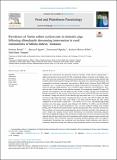| dc.description.abstract | Taeniosis and cysticercosis are infections caused by cestodes, Taenia solium is among them. T.solium neurocysticercosis accounts for 30% of acquired epilepsy in human in developing countries. This study was carried out to determine the prevalence of cysticercosis among domestic pigs in Mbulu district following deworming intervention. The study was conducted among three rural communities monitoring community intervention in Mbulu district between March 2020 and September 2021. Live pigs were diagnosed by lingual examination for the presence of T. solium cysticerci, and pig-rearing practices were recorded. Logistic regression was performed to determine the role of risk factors on pig infection outcome. We conveniently sampled 510 pigs; 267 (52.4%) were sampled in the year 2020 and 243 (47.6%) in 2021. All pigs were examined by lingual examination for the presence of pork tapeworm larvae, and 43 (8.4%) pigs were found to be infected. Twenty-one (48.8%) of the infected pigs were males and 22 (51.2%) were females, and the overall annual prevalence of tapeworm larvae was 9% and 7.8% for 2020 and 2021, respectively. The pigs were twice more likely to be found infected during the rainy season compared to the dry season in 2020 (OR = 2.27, 95%CI of 1.16–7.22). The reported pig-rearing practices were free-range, penned, and tethered, 141 (52.8%), 64 (24%), and 62 (23.2%), respectively. Of the 94 visited households in 2020, 78 (83%) reported drinking water without boiling, and 59 (62.8%) household leaders reported having heard about taeniosis/cysticercosis. The prevalence of cysticercosis among domestic pigs in this study was high, with seasonal variations. Despite the ongoing national school deworming and community deworming program, there was no significant change in the prevalence of cysticercosis over two consecutive years. The reported pig infections imply fecal-oral transmission with humans tapeworm eggs released from infected humans. Most households reported consuming unboiled drinking water that might be contaminated. Integrating pig vaccination and deworming, health education and school or community deworming along with improved pig management practice and general community water sanitation hygiene (WASH) are recommended to reduce the burden of pork tapeworm in the study communities. | en_US |

